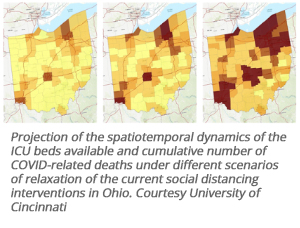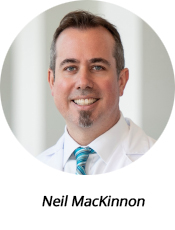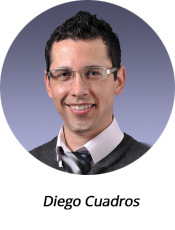
Social distancing interventions during the COVID-19 pandemic have saved lives in Ohio, but projections from the University of Cincinnati’s College of Pharmacy and its departments of math and geography show that significant relaxation of these measures would create a substantial strain on healthcare resources.
 The recently developed public health policy brief and mapping tool from the Geospatial Health Advising Group at UC comes as state governors begin to ease social distancing restrictions and “reopen” their states in phases.
The recently developed public health policy brief and mapping tool from the Geospatial Health Advising Group at UC comes as state governors begin to ease social distancing restrictions and “reopen” their states in phases.
Neil MacKinnon, dean and professor at the James L. Winkle College of Pharmacy at UC, said the idea was to provide policymakers with new information using scientific research, mapping, and mathematical modeling. MacKinnon and other researchers at the Geospatial Health Advising Group previously used similar modeling to publish data evaluating whether an Ohio law allowing pharmacists to dispense naloxone without a prescription was associated with an increase in naloxone dispensing rates.
In this case, the group’s analysis suggests that if interventions are minimally relaxed, the critical care demand for COVID-19 patients will remain stable. However, if interventions are eased by 50% or 70% (defined as policy changes that reduce mitigation impact by 50% and 70% respectively), the state would need to revert to strict restrictions within six weeks.
Researchers also found that social distancing restrictions saved nearly 700 lives and reduced hospitalizations by more than 10,000 cases through mid-April.
 “Hopefully our brief is a powerful reminder that if you relax restrictions too fast, there is a very high likelihood that people will die unnecessarily,” MacKinnon said. “We have seen the power of flattening the curve in other parts of the country and we may not be so lucky if we remove those restrictions too quickly … As states relax restrictions there will continue to be an impact on health system pharmacists. If states let up, we may be back where we were before where we are worried about capacity issues.”
“Hopefully our brief is a powerful reminder that if you relax restrictions too fast, there is a very high likelihood that people will die unnecessarily,” MacKinnon said. “We have seen the power of flattening the curve in other parts of the country and we may not be so lucky if we remove those restrictions too quickly … As states relax restrictions there will continue to be an impact on health system pharmacists. If states let up, we may be back where we were before where we are worried about capacity issues.”
The geospatial mapping technique was developed by Diego Cuadros, assistant professor of health geography and disease modeling at UC. The model stratifies the Ohio population into four groups depending on the spatial risk characteristics of each county – the counties with airports, the counties surrounding those with airports, the counties with main highways, and lastly the counties in rural areas without main highways.
 “We have an epidemic in Ohio composed by four different micro epidemics,” explained Cuadros, who studies the geographic spread of infectious diseases. “With this information, we generated the maps to try to make projections about what’s going to happen. We needed to estimate, ‘What is the impact of the intervention on the speed of the epidemic?’”
“We have an epidemic in Ohio composed by four different micro epidemics,” explained Cuadros, who studies the geographic spread of infectious diseases. “With this information, we generated the maps to try to make projections about what’s going to happen. We needed to estimate, ‘What is the impact of the intervention on the speed of the epidemic?’”
Researchers modeled the dynamic of the disease transmission and infection complications in each group using seven epidemiological compartments for the susceptible, infected, recovered, hospitalized, ICU admitted, recovered after hospitalization, and death population, according to their public health policy brief. Cuadros said the team’s multidisciplinary approach, and having the perspective of a pharmacist with a public health policy background, was critical to the project.
They used data collected by the Ohio Department of Health prior to the implementation of the state’s stay-home order. At that time, COVID-19 was on pace to kill more than 1,000 people in Ohio had the state not enacted strict measures.
Looking at the current level of social distancing interventions, the model projected 4,816 COVID-19-related hospitalizations by June 1 compared to 7,686 if interventions were relaxed moderately (50%) and 10,886 if they were relaxed significantly (by 70%). Other findings included:
- 1,073 deaths by June 1 compared to 1,367 deaths with moderate relaxing of interventions and 1,629 deaths with significant relaxing of interventions.
- With moderate relaxing of interventions, 67 of Ohio’s 88 counties would reach ICU capacity for patients with COVID-19 by June 30. With significant relaxing of interventions, full ICU capacity would be reached by June 13, with a projected 7,000 ICU beds needed by June 30. Ohio currently has 3,743 ICU beds.
An important component to the tool is the ability to drill down county by county to project the impact of lifting restrictions at a certain point in time on healthcare resources such as hospital beds and intensive care unit capacity. This is a powerful level of detail that can be used by Department of Health Officials, county health officials, and health system pharmacy leaders for planning purposes, MacKinnon said.
“While COVID-19 has primarily impacted urban parts of the country, the capacity to respond to a second wave is actually more restricted in rural parts. … they do not have the capacity to address a surge,” MacKinnon said.
Researchers say their model can be replicated in other states and that they hope policymakers will consider their projections as they consider easing restrictions.
“Governors are under a lot of pressure from all sides – everyone is feeling it,” MacKinnon said. “But at the same time we can’t forget, if you look at the science of COVID-19 and the epidemiology of it, this is not the time to take your foot off the gas as far as restrictions and completely reopen because we will see the negative impact.”
Cuadros agreed, and said relaxing restrictions could be a good strategy as long as it is done in a deliberate and measured manner.
“More people in the street means more infections, more hospitalizations and unfortunately more deaths,” Cuadros said. “We have to keep the healthcare system healthy … Because we don’t have any other intervention – no treatment, no vaccine – we are buying time to avoid a collapse of the healthcare system.”
For more information and free tools regarding the pandemic, including our regularly updated Assessment of Evidence for COVID-19-Related Treatments, visit ASHP’s COVID-19 Resource Center and the COVID-19 Community at ASHP Connect.








